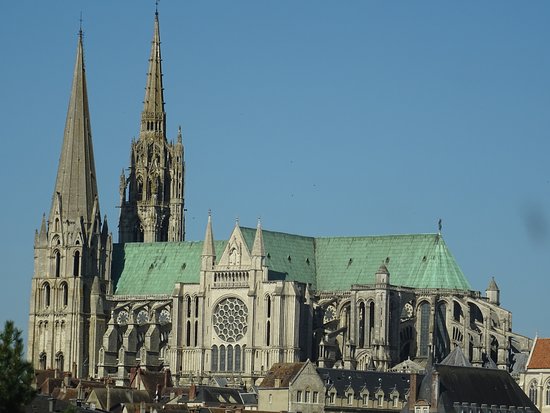Built between 1190 and 1220 CE, the Chartres Cathedral represents one of Europe's finest works in the Central Middle Ages with its blend of Gothic and Romanesque architecture. The cathedral became a central site for pilgrimages and was even the site of the pilgrimage devoted to the Virgin Mary, which is one of the most famous pilgrimages in all of Christianity. The famous cathedral hosted the coronation of French king King Henry IV and was the place where Saint Bernard of Clairvaux helped convince people to embark in the Second Crusade. The cathedral have also had many additions and renovations throughout the 13th and 14th centuries, including the treasury at the Saint Piat Chapel and a generous donation by Louis XII to replace a steeple destroyed by lightning. It was also a great place for learning, as it was known as one of the top scholarly places in France until the opening of the University Of Paris in the mid-11th century. It was even acknowledged as a world heritage site in 1979 CE.
 When the cathedral was first being constructed in the 9th century, the dominant architecture style used was romanesque, since it was still very popular at the time. As the gothic style started to rise in popularity though, the walls and chapels switched between the romanesque and gothic styles. The gothic influences are apparent with its flying buttresses on the outside and its cross-ribbed ceiling on the inside. One of the more famous aspects of the cathedral however is the beauty of its numerous stained glass windows and marvelous sculptures, which were mostly built from 1210 to 1250 CE and are still well preserved today. The Royal Portal highlights the cathedral's structural marvels, consisting of three doorways built right next to each other with three stained glass windows above each one. Separating the three entryways are sculptures of important old testament figures and even Judah himself. These sculptures can also be found in the west portal and in the porches of the building. The flooring of the cathedral is designed with the path of a labyrinth, and the faithful would walk around its 261.5 meter maze to imitate those who went on the famous pilgrimage to Jerusalem. The stained glass windows, religious sculptures, and various uses of gothic and romanesque architecture make this French cathedral stand out and remain authentic through the years.
When the cathedral was first being constructed in the 9th century, the dominant architecture style used was romanesque, since it was still very popular at the time. As the gothic style started to rise in popularity though, the walls and chapels switched between the romanesque and gothic styles. The gothic influences are apparent with its flying buttresses on the outside and its cross-ribbed ceiling on the inside. One of the more famous aspects of the cathedral however is the beauty of its numerous stained glass windows and marvelous sculptures, which were mostly built from 1210 to 1250 CE and are still well preserved today. The Royal Portal highlights the cathedral's structural marvels, consisting of three doorways built right next to each other with three stained glass windows above each one. Separating the three entryways are sculptures of important old testament figures and even Judah himself. These sculptures can also be found in the west portal and in the porches of the building. The flooring of the cathedral is designed with the path of a labyrinth, and the faithful would walk around its 261.5 meter maze to imitate those who went on the famous pilgrimage to Jerusalem. The stained glass windows, religious sculptures, and various uses of gothic and romanesque architecture make this French cathedral stand out and remain authentic through the years.Works Cited
Cartwright, Mark. "Chartres Cathedral." Ancient History Encyclopedia, 15 October 2018, https://www.ancient.eu/Chartres_Cathedral/.
"Chartres Cathedral." UNESCO World Heritage Centre, https://whc.unesco.org/en/list/81/.





Another beautiful church i like how it took so long to finish that they decided to change it half way through. I would hate to have to clean those windows!
ReplyDeleteI made my post on the Cologne Cathedral, and it was made as a celebration of the Assumption of the Virgin Mary. The time and effort that must have went into creating these cathedrals as a devotion to one person. It definitely shows some serious dedication!
ReplyDeleteI think it is so incredible how certain pieces of medieval structures like this can be preserved. I think the fact that the stained glass still remains today is so fascinating.
ReplyDeleteI find it interesting that the Chartres Cathedral combines both Romanesque and Gothic architecture, and that renovations that have existed throughout its history have allowed the cathedral to maintain its medieval charm through the years. It is also interesting to see how churches in the Middle Ages were more than a traditional center of worship and became social gathering places that permitted people the ability to become educated and express their opinions openly.
ReplyDelete